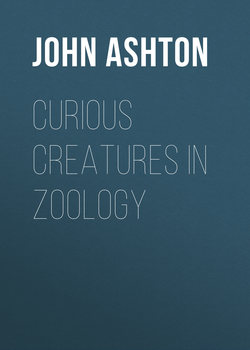Читать книгу Curious Creatures in Zoology - Ashton John - Страница 9
CURIOUS CREATURES
The Ouran Outan
ОглавлениеTransition from hirsute humanity to the apes, is easy, and natural – and we need only deal with the Simiinæ, which includes the Orang, the Chimpanzee, and the Gorilla. These are the largest apes, and nearest approach to man – but, although they may be tailless, yet there is that short great toe which prevents any acceptation of their humanity. The orang is exclusively an inhabitant of Borneo and Sumatra, and in those two islands it may be found in the swampy forests near the coast. It grows to a large size, for an ape, about four feet four inches high, but is neither so large, nor so strong, as the Gorilla. Compared with man, its arms seem to be as extravagantly long, as its legs are ridiculously short. When wild, it feeds entirely on vegetable diet, and makes a kind of house, or nest, in trees, interweaving the branches, so as to obtain shelter. They do not stand confinement well, being languid and miserable – but, in their native wildness, they can, if necessity arises, fight well in their own defence. A. R. Wallace, in his “Malay Archipelago; the Land of the Orang Utan and the Bird of Paradise,” tells the following story of its combativeness.
“A few miles down the river there is a Dyak house, and the inhabitants saw a large orang feeding on the young shoots of a palm by the river side. On being alarmed, he retreated towards the jungle, which was close by, and a number of the men, armed with spears and choppers, ran out to intercept him. The man who was in front, tried to run his spear through the animal’s body, but the orang seized it in his hands, and in an instant got hold of the man’s arm, which he seized in his mouth, making his teeth meet in the flesh above the elbow, which he tore and lacerated in a dreadful manner. Had not the others been close behind, the man would have been seriously injured, if not killed, as he was quite powerless; but they soon destroyed the creature with their spears and choppers. The man remained ill for a long time, and never fully recovered the use of his arm.”
It is called the Simia Satyrus; probably on its presumed lustfulness, certainly not on account of its resemblance to the satyr of antiquity.
Gesner gives us his idea of the orang, presenting us with the accompanying figure of the Cercopithecus, and quotes Cardanus as saying that the Cercopithecus or Wild-man, is singularly made, having the height and form of a man, with legs like man’s – and is covered all over with hair. No animal can withstand it, with the exception of man, to whom, when in its own regions, it is not inferior. It loves boys and women.
Pliny speaks of the Satyr Ape thus: “Among the mountainous districts of the eastern parts of India, in what is called the country of the Catharcludi, we find the Satyr, an animal of extraordinary swiftness. They go sometimes on four feet, and sometimes walk erect; they have, also, the features of a human being. On account of their swiftness, these creatures are never to be caught, except when they are aged, or sickly,” and, in another place, he says, “The Sphyngium and the Satyr stow away food in the pouches of their cheeks, after which they will take out piece by piece in their hands, and eat it.”
Topsell has mixed up the Simia Satyrus with the classical satyr, having legs and horns like goats; but he evidently alludes to the former in this passage. “The Satyres are in the Islands Satiridæ, which are three in number, right over against India on the farther side of the Ganges; of which Euphemus Car rehearseth this history: that when he sailed unto Italy, by the rage of winde and evill weather, they were driven to a coast unnavigable, where were many desart Islandes, inhabited of wild men, and the marriners refused to land upon some Islands, having heretofore had triall of the inhumaine and uncivill behaviour of the inhabitants, so that they brought us to the Satyrian Islands, where we saw the inhabitants red, and had tayles joyned to their backs, not much lesse than horsses. These, being perceived by the marriners to run to the shippes, and lay hold on the women that were in them, the shipmen, for feare, took one of the Barbarian women, and set her on the land among them, whom in most odious and filthy manner, they abused, whereby they found them to be very bruit beasts.”
He gives us his idea of the Simia Satyrus, which must have been an accomplished animal, for not only could it, apparently, play upon the pipe, but it had a handy pouch for the reception of the fruit (in lieu of coppers) which it doubtless would receive as guerdon for its performance.
